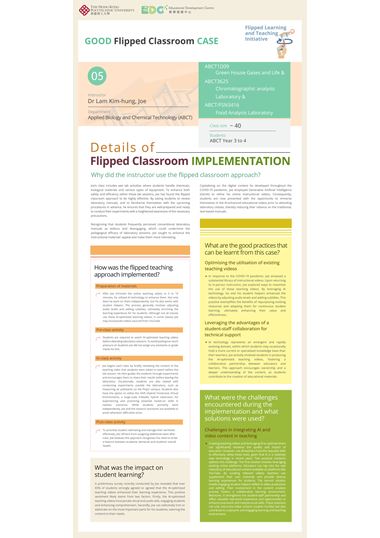
General Information
- Instructor: Dr Lam Kim-hung, Joe
- Department: Department of Applied Biology and Chemical Technology
- Subject: ABCT1D09 Green House Gases and Life & ABCT3625 Chromatographic analysis Laboratory & ABCT/FSN3416 Food Analysis Laboratory
- Class Size: ~40
- Students: Year 3 to 4 students from ABCT
Why Use the Flipped Classroom Approach?
Joe’s class includes wet lab activities where students handle chemicals, biological materials and various types of equipment. To enhance both safety and efficiency within these lab sessions, Joe has found the flipped classroom approach to be highly effective. By asking students to review laboratory manuals, and to familiarise themselves with the upcoming procedures in advance, he ensures that they are well-prepared and ready to conduct their experiments with a heightened awareness of the necessary precautions.
Recognising that students frequently perceived conventional laboratory manuals as tedious and disengaging, which could undermine the pedagogical efficacy of laboratory sessions, Joe sought to enhance the instructional materials' appeal and make them more interesting. Capitalising on the digital content he developed throughout the COVID-19 pandemic, Joe employed Generative Artificial Intelligence (GenAI) to refine his online instructional videos. Consequently, students are now presented with the opportunity to immerse themselves in the AI-enhanced educational videos prior to attending laboratory classes, thereby reducing their reliance on the traditional, text-based manuals.
Implementation Steps
Materials preparation
After Joe trimmed the online teaching videos to 5 to 10 minutes, he utilised AI technology to enhance them. Not only does he work on them independently, but he also works with student helpers. The process generally involves adjusting audio levels and adding subtitles, ultimately enriching the learning experience for his students. Although not all classes use these AI-optimised teaching videos, in some classes Joe may incorporate videos sourced from YouTube.
Pre-class activity
Students are required to watch AI-optimised teaching videos before attending laboratory sessions. To avoid putting too much pressure on students, Joe did not assign any assistants or grade marks for this.
In-class activity
Joe begins each class by briefly reviewing the content of the teaching video that students were asked to watch before the lab session. He then guides the students through experiments and encourages them to share their results before leaving the laboratory. Occasionally, students are also tasked with conducting experiments outside the laboratory, such as measuring air pollutants on the PolyU campus. Students also have the option to utilise the HiVE (Hybrid Immersive Virtual Environment), a large-scale X-Reality hybrid classroom, for experiencing and practicing essential hands-on skills in realistic scenarios. While students primarily work independently, Joe and the research assistants are available to assist whenever difficulties arise.
After-class activity
To prioritise student well-being and manage their workload effectively, Joe refrains from assigning additional tasks after class. Joe believes this approach recognises the need to strike a balance between academic demands and students’ overall health.
What Impact Did This Have on Student Learning?
A preliminary survey recently conducted by Joe revealed that over 65% of students strongly agreed or agreed that the AI-optimised teaching videos enhanced their learning experience. This positive sentiment likely stems from two factors. Firstly, the AI-optimised teaching videos incorporate visual and audio aids, engaging students and enhancing comprehension. Secondly, Joe can selectively trim or elaborate on the most important parts for his students, tailoring the content to their needs.
What Are the Good Practices That Can Be Learnt from This Case?
Optimising the utilisation of existing teaching videos
In response to the COVID-19 pandemic, Joe amassed a substantial library of instructional videos. Upon returning to in-person instruction, Joe explored ways to maximise the use of these teaching videos. By keveraging AI technology, he and his student helpers enhanced the videos by adjusting audio levels and adding subtitles. This practice exemplifies the benefits of repurposing existing resources and adapting them for continuous student learning, ultimately enhancing their value and effectiveness.
Leveraging the advantages of a student-staff collaboration for technical support
AI technology represents an emergent and rapidly evolving domain, within which students may occasionally hold a more current or specialised knowledge base than their teachers. Joe actively involved students in producing the AI-optimised teaching videos, fostering a collaborative partnership between educators and learners. This approach encourages ownership and a deeper understanding of the content, as students contribute to the creation of educational materials.
What Were the Challenges Encountered During the Implementation and What Solutions Were Used?
Challenges in integrating AI and video content in teaching
Creating teaching videos and leveraging AI to optimise them can significantly enhance the quality and impact of education. However, not all teachers have the requisite skills to effectively utilise these tools, given that AI is a relatively new technology in recent years. Two practical solutions address this challenge. The first solution involves leveraging existing online platforms. Educators can tap into the vast repository of educational content available on platforms like YouTube. By curating relevant videos, teachers can supplement their own materials and provide diverse learning experiences for students. The second solution entails engaging student helpers skilled in video production and editing. Their involvement in the content creation process fosters a collaborative learning environment. Moreover, it strengthens the student-staff partnership and offers valuable real-world experience and opportunities to enhance teamwork and interpersonal skills. These solutions not only overcome initial content creation hurdles but also contribute to a dynamic and engaging learning and teaching environment.

